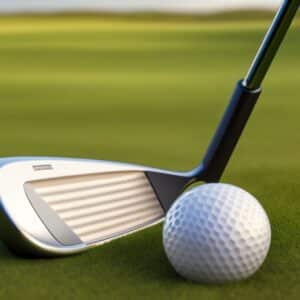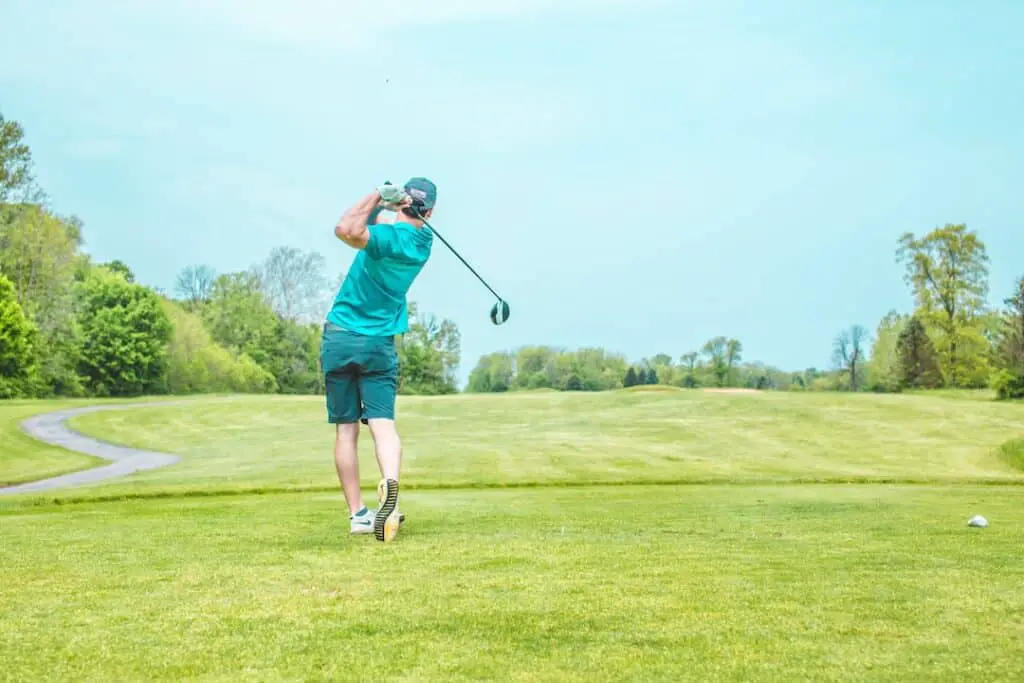Last Updated on June 7, 2023
The golf swing is a complex motion requiring exact synchronisation of multiple body parts for the player to achieve a successful shot. One common issue that arises during the golf swing is lifting one’s head prematurely from its established position at address. This misstep can lead to poor ball flight and diminished distance off the tee or on approach shots. Fortunately, with attention to detail and proper instruction on technique, this issue can be addressed and corrected. This article will discuss how to stop lifting your head in a golf swing so players can improve their accuracy and reach their desired performance goals on the course.
Effective Posture
Good posture is an essential element of proper golfing technique. The most basic advice for maintaining optimal posture while out on the course is to keep your head down and maintain a steady, balanced stance throughout the swing. This can be difficult if one has developed bad habits such as lifting their head during a swing. To maximise performance and prevent injury, it is important to learn how to stop this habit as soon as possible.
When addressing the ball at address position, ensure that your feet are shoulder-width apart and that your knees remain slightly bent – this will allow for maximum stability when hitting your shot. Additionally, make sure that you have flexed elbows with wrists set in line with them; this helps create effective wrist hinge motion and promotes good golfing posture. Aim to focus on these elements throughout the entire backswing; keeping all body parts in alignment until impact ensures that there is no unnecessary pressure or tension placed upon any single limb during the process. Furthermore, be mindful not to lift your head too far off the ground; doing so could lead to misaligned shots or even injuries due to strain caused by improper form.
Training With a Mirror
By utilising a golf mirror for practise sessions, players will also become more aware of any unwanted movements or adjustments occurring throughout the swing due to incorrect weight distribution or faulty mechanics. This heightened awareness helps them identify what needs improvement so they can make changes accordingly and ultimately reduce the chances of lifting their head during the downswing. In addition, repeating drills while looking into the mirror reinforces good habits such as maintaining balance and keeping arms close together throughout each repetition.
Therefore, regular use of a golf swing mirror allows players to hone in on specific parts of their game needed for correction, refine overall technique, and improve performance on the course.
Keeping Your Eyes on the Ball
Maintaining a focus on the golf ball is essential for optimising your swing. Keeping your eyes on the ball will help you avoid lifting your head too early in the backswing, resulting in an inefficient and ineffective shot. Here are three tips to keep in mind to ensure that you stay focused:
- Maintain proper posture throughout the entire swing. This can be achieved by keeping your feet shoulder-width apart, with slight flexion of the knees, hips slightly bent forward, and shoulders relaxed.
- During setup, it is important to look directly towards the target line and have your chin slightly tucked to maintain focus during the swing.
- Visualise each portion of the swing before executing it; this helps train your body and mind to remember what needs to be done during different parts of the swing sequence.
By adhering to these tips, you should find yourself keeping better track of where the golf ball is located at all times while avoiding unnecessary movements such as lifting your head prematurely. In addition, maintaining good form throughout your shots allows for more consistent results off of each tee box or fairway lie.
Rotating Your Hips and Shoulders

Rotating your hips and shoulders correctly is an essential element of a successful golf swing. To ensure proper hip rotation, try to keep the bulk of your weight on the inside of your back foot during your backswing. As you do so, rotate your left shoulder towards the target as if it were a hinge while keeping your arms in front of you. This will help reduce lifting your head during the swing and allow for better control over ball contact.
To further improve rotational mechanics, implement drills that focus on hip turn with minimal upper body movement. For example, practise swinging without using either arm by only rotating the hips around a stationary spine angle and focusing on creating power through core strength instead of relying solely on arm action. Additionally, limit any excessive lateral motion to properly square up the clubface at impact which also helps prevent unwanted head lift. With consistent practise employing these tips and drills, one can develop more efficient golf swings free from unnecessary head lift.
Utilising Weighted Clubs
Weighted golf clubs can be utilised as a training tool to help reduce the tendency of lifting one’s head in the golf swing. By utilising weighted golf clubs for practise swings and drills, it is possible to develop strength in the muscles that support the spine during backswing and downswing movements. Additionally, it will create an awareness of proper weight transfer from address through impact by reinforcing good body mechanics. Weighting your golf club also encourages a more relaxed grip pressure which creates greater clubhead speed with less effort while avoiding the common mistake of using the upper body to lift or force the ball into flight.
Frequently Asked Questions
How Can I Practise My Golf Swing Without a Driving Range?

Golfers looking to improve their game without the use of a driving range should try various golf swing drills. These drills focus on different aspects of the swing such as posture, grip strength, and club speed. Additionally, they also work on building muscle memory so that when out on the course, the golfer will know exactly how to make each shot. With enough repetition and dedication to these drills, improvement in form and distance is achievable even without access to a driving range.
Aside from golf swing drills, practising at home with no equipment is still possible by visualising shots or making swings through empty air. This can be done either indoors or outdoors depending on preference and space available; however, it may not provide all the same benefits as working with actual clubs or balls. Practising golf swings this way can have a positive effect on developing consistency which is key for any golfer hoping to lower their handicap score. Furthermore, watching instructional videos online can offer additional tips and advice for small tweaks that could yield big results over time.
How Can I Tell if I Am Lifting My Head Too Far During the Golf Swing?
Maintaining proper head position during the golf swing is essential for achieving a successful shot. Eye line and form can both suffer if the golfer lifts their head too far. Therefore, it is important to know how to tell when this problem arises.
To start, keeping the eyes in line with the ball throughout the entire swing is key to maintaining constant contact between the clubface and ball. If there is any disruption of the eye line, it could be an indication that the player’s head has lifted off its original spot at address. Additionally, having a consistent tempo in one’s backswing can also help detect whether or not they are lifting their heads. Finally, focusing on where your body moves during the golf swing can provide valuable information about potential changes in head position.
When assessed together, these three techniques – eye line, tempo and focus – can give insight into whether a golfer may need to adjust their stance or modify other aspects of their swing mechanics due to improper head positioning during execution. With practice and diligence, players can develop better habits that will result in more consistently solid shots from the tee box to green.
Conclusion
In conclusion, learning how to stop lifting your head in a golf swing might take a long shot but dedicated effort and practice with proper technique can help optimise your swinging performance. Utilising weighted clubs and increasing grip strength can be beneficial for achieving muscle memory without accessing a driving range. Lastly, self-monitoring can assist with recognising whether one is unnecessarily lifting the head during their swing, as this could lead to undesirable results on the course.



